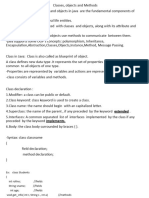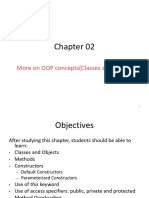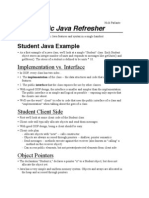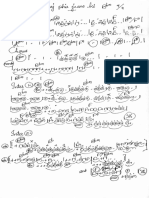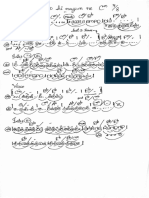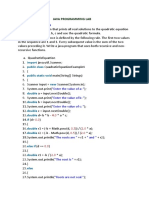0 ratings0% found this document useful (0 votes)
63 viewsIntroduction To Programming Using JAVA - Lecture 5
This document provides an introduction to programming using Java. It defines objects and classes, explaining that objects have attributes and behaviors while classes are templates for objects. It gives examples of an Employee object and class. It also covers creating objects using the new operator, accessing object methods, constructors for initializing objects, and the this and super keywords. The summary provides key definitions and concepts in the document for understanding objects and classes in Java.
Uploaded by
Rochana RamanayakaCopyright
© Attribution Non-Commercial (BY-NC)
Available Formats
Download as PDF, TXT or read online on Scribd
0 ratings0% found this document useful (0 votes)
63 viewsIntroduction To Programming Using JAVA - Lecture 5
This document provides an introduction to programming using Java. It defines objects and classes, explaining that objects have attributes and behaviors while classes are templates for objects. It gives examples of an Employee object and class. It also covers creating objects using the new operator, accessing object methods, constructors for initializing objects, and the this and super keywords. The summary provides key definitions and concepts in the document for understanding objects and classes in Java.
Uploaded by
Rochana RamanayakaCopyright
© Attribution Non-Commercial (BY-NC)
Available Formats
Download as PDF, TXT or read online on Scribd
You are on page 1/ 0
Kasun@ Kasun@cmb cmb.ac. .ac.lk lk UCSC 2003. All rights reserved.
No part of this material may be reproduced and sold.
1
Introduction to Programming
Introduction to Programming
(
(
Using Java)
Using Java)
Nandika Kasun
Nandika Kasun
University of Colombo School of Computing (UCSC)
University of Colombo School of Computing (UCSC)
University of Colombo
University of Colombo
Sri Lanka
Sri Lanka
Kasun@ Kasun@cmb cmb.ac. .ac.lk lk UCSC 2003. All rights reserved. No part of this material may be reproduced and sold.
2
Definition of a(n) Object/Class
Definition of a(n) Object/Class
What is an Object :
A thing may have a physical presence
such as a table ,chair or an abstract
concept such as a job .
An object is an abstract representation of a
thing in the real world.
We simulate a problem domain in the real-
world through objects.
Kasun@ Kasun@cmb cmb.ac. .ac.lk lk UCSC 2003. All rights reserved. No part of this material may be reproduced and sold.
3
Objects
Objects
An object has a unique identity, attributes (What it
knows or data about it), and behavior (What it can
do).
Eg
Eg
:
:
An Employee object (say employee) will have the
following attributes (what it knows):
name, age, salary
It will have the following behavior (what it can do):
set salary, get salary, set name, set age
Kasun@ Kasun@cmb cmb.ac. .ac.lk lk UCSC 2003. All rights reserved. No part of this material may be reproduced and sold.
4
Classes
Classes
What is a Class?
Objects are the representation of things in the
real world
Classes are templates for objects, ie. They
contain all the common properties and behavior
of a group of objects.
All objects with the same characteristics and
behaviors belongs to the same class.
Kasun@ Kasun@cmb cmb.ac. .ac.lk lk UCSC 2003. All rights reserved. No part of this material may be reproduced and sold.
5
Java Application
Java Application
A Java application is a collection of one or
more Java classes.
At least one of the classes is public and
contains a method named main() except in
case of applets..
Kasun@ Kasun@cmb cmb.ac. .ac.lk lk UCSC 2003. All rights reserved. No part of this material may be reproduced and sold.
6
public class Employee {
private String name;
private int age;
private float salary;
public void setName(String tName) {
Name = tName; }
public void setSalary (float tSalary) {
salary = tSalary; }
public float getSalary () {
return salary; }
}
Objects and Classes
Objects and Classes
An example
class Declaration
Attributes
Methods
Kasun@ Kasun@cmb cmb.ac. .ac.lk lk UCSC 2003. All rights reserved. No part of this material may be reproduced and sold.
7
Creating Objects
Creating Objects
Objects are created by instantiating classes.
To use a class in a program, you must first create an
instance of it.
Objects of a class can be created using the
new
new
operator.
Example Employee newEmp = new Employee();
Class Name
Variable containing
an Object reference
Constructor
Kasun@ Kasun@cmb cmb.ac. .ac.lk lk UCSC 2003. All rights reserved. No part of this material may be reproduced and sold.
8
Creating Objects
Creating Objects
Object References
following declaration will create an Object reference
Employee newEmp2 ;
The newEmp2 variable
will have value null
newEmp2
You can create
multiple References
to the same object
Employee newEmp;
newEmp = new Employee();
newEmp2 = newEmp;
newemp
newemp2
newEmp
Kasun@ Kasun@cmb cmb.ac. .ac.lk lk UCSC 2003. All rights reserved. No part of this material may be reproduced and sold.
9
Destroying Objects
Destroying Objects
Javas garbage collection is automatic
There is no great need for an explicit destructor.
finalize method plays the role of a destructor.
This method is useful to disconnect network
connections as well as close any open databases
Kasun@ Kasun@cmb cmb.ac. .ac.lk lk UCSC 2003. All rights reserved. No part of this material may be reproduced and sold.
10
Objects and Classes
Objects and Classes
A basic method definition is as follows:
modifier returnType MethodName (parameter List) {
statement(s);
}
Optional
Can be any primitive type
or a class Name or
void (no return statement)
Usually the modifier for methods
is public and for attributes it is private
Kasun@ Kasun@cmb cmb.ac. .ac.lk lk UCSC 2003. All rights reserved. No part of this material may be reproduced and sold.
11
Objects and Classes
Objects and Classes
The return Type, Method Name, and the
parameter list defines the Signature of the
method
It is possible to define two or more methods
with the same name within the same class
(Method Overloading) with different signatures
public void CreatePoint( )
public void CreatePoint(int x , y)
Kasun@ Kasun@cmb cmb.ac. .ac.lk lk UCSC 2003. All rights reserved. No part of this material may be reproduced and sold.
12
Objects and Classes
Objects and Classes
Accessing methods
a instance method can be accessed using the
dot(.) operator as shown below.
ObjectName.method();
A class method can be accessed by using the
class name followed by a period and then the
method name
Integer.parseInt(25);
Kasun@ Kasun@cmb cmb.ac. .ac.lk lk UCSC 2003. All rights reserved. No part of this material may be reproduced and sold.
13
Passing parameters
all parameters (except Object types such as
instances of classes and Arrays etc.) are passed
by value.
i.e. any modifications done within the method
does not affect the original variable.
Objects and Classes
Objects and Classes
if you require to modify the original variables,
and needs to pass those to a method
Declare those as instance variables in a class
and pass an object of that class to the method
Kasun@ Kasun@cmb cmb.ac. .ac.lk lk UCSC 2003. All rights reserved. No part of this material may be reproduced and sold.
14
Constructors
Constructors
Constructor Methods
These methods are used to initialize objects
they have the same name as the class and have
no return type
these methods are called automatically when the
new operator is used to allocate memory for an
object.
Kasun@ Kasun@cmb cmb.ac. .ac.lk lk UCSC 2003. All rights reserved. No part of this material may be reproduced and sold.
15
Constructors
Constructors
Overloading Constructors
A class can have multiple Constructors
(Overloaded Constructors)
All carries the same name
They have either different number of
arguments or different types of arguments
Kasun@ Kasun@cmb cmb.ac. .ac.lk lk UCSC 2003. All rights reserved. No part of this material may be reproduced and sold.
16
Constructors
Constructors
Example for Constructors
public class twoDPoint {
float x,y;
twoDPoint ( ) {
x= y = 0;
}
}
No argument
Constructor
Kasun@ Kasun@cmb cmb.ac. .ac.lk lk UCSC 2003. All rights reserved. No part of this material may be reproduced and sold.
17
Constructors
Constructors
Example for Constructors
public class twoDPoint {
float x,y;
twoDPoint ( ) {
x= y = 0;
}
twoDPoint ( float a , float b) {
x=a;
y=b;
}
}
No argument
Constructor
Overloaded
constructor
Kasun@ Kasun@cmb cmb.ac. .ac.lk lk UCSC 2003. All rights reserved. No part of this material may be reproduced and sold.
18
This Keyword
This Keyword
this keyword
this keyword is used to refer to the
current object.
It can be used to :
refer to the current objects member variables
refer to current objects methods
pass a reference to the current object to a method
return a reference current object
Kasun@ Kasun@cmb cmb.ac. .ac.lk lk UCSC 2003. All rights reserved. No part of this material may be reproduced and sold.
19
This Keyword
This Keyword
this keyword
t=this.x;
this.myMethod(this);
return this;
Refers to the member
variable x in this object
Call the myMethod
defined in this class
and pass its this Object
Return this Object
Kasun@ Kasun@cmb cmb.ac. .ac.lk lk UCSC 2003. All rights reserved. No part of this material may be reproduced and sold.
20
Super Keyword
Super Keyword
super keyword
This keyword is used to refer to the Super or
parent class
super( );
super(x,y);
super.f( );
Invokes super class Constructor
Invokes super class Constructor
with x and y arguments
Calls the super class function
called f( )
Kasun@ Kasun@cmb cmb.ac. .ac.lk lk UCSC 2003. All rights reserved. No part of this material may be reproduced and sold.
21
Summary
Summary
This week we learned Objects and Classes
Exercise:
Exercise:
Implement Java objects for represent a Chair, a Car and a
Implement Java objects for represent a Chair, a Car and a
Student. You should define attributes and methods of these
Student. You should define attributes and methods of these
objects.
objects.
You might also like
- Lecture 6: Objects and Classes: Topics CoveredNo ratings yetLecture 6: Objects and Classes: Topics Covered7 pages
- More On Java: CS4280 Advanced Internet Applications DevelopmentNo ratings yetMore On Java: CS4280 Advanced Internet Applications Development84 pages
- Class Object Difference Between Struct and ClassNo ratings yetClass Object Difference Between Struct and Class7 pages
- Programming and Problem Solving Lecture - 15-Classes and ObjectsNo ratings yetProgramming and Problem Solving Lecture - 15-Classes and Objects44 pages
- Object Oriented Programming Structure - Features of OOPS: Objects / Instance Classes Inheritance PolymorphismNo ratings yetObject Oriented Programming Structure - Features of OOPS: Objects / Instance Classes Inheritance Polymorphism168 pages
- MZ Chapter - 2 - Objects and Classes Full OopNo ratings yetMZ Chapter - 2 - Objects and Classes Full Oop61 pages
- Introduction To Java Programming: Week 5No ratings yetIntroduction To Java Programming: Week 538 pages
- Object Oriented Programming (Java) Lecture Notes Unit 2No ratings yetObject Oriented Programming (Java) Lecture Notes Unit 225 pages
- 95712C Lecture Notes Wednesday, September 15, 2004: Objects and ClassesNo ratings yet95712C Lecture Notes Wednesday, September 15, 2004: Objects and Classes7 pages
- Object Life Cycle: You Create An Object From A Class by UsingNo ratings yetObject Life Cycle: You Create An Object From A Class by Using37 pages
- A Second Look at Classes and Objects: Starting Out With Java: From Control Structures Through Objects Fifth EditionNo ratings yetA Second Look at Classes and Objects: Starting Out With Java: From Control Structures Through Objects Fifth Edition40 pages
- IGNOU PGDCA MCS 206 Object Oriented Programming using Java Previous Years solved PapersFrom EverandIGNOU PGDCA MCS 206 Object Oriented Programming using Java Previous Years solved PapersNo ratings yet
- Java Package Mastery: 100 Knock Series - Master Java in One Hour, 2024 EditionFrom EverandJava Package Mastery: 100 Knock Series - Master Java in One Hour, 2024 EditionNo ratings yet
- Cracking Kotlin Interview: Solutions to Your Basic to Advanced Programming QuestionsFrom EverandCracking Kotlin Interview: Solutions to Your Basic to Advanced Programming Questions5/5 (1)
- Java Programming Tutorial With Screen Shots & Many Code ExampleFrom EverandJava Programming Tutorial With Screen Shots & Many Code ExampleNo ratings yet
- Software Requirement Specification Software Engineering100% (1)Software Requirement Specification Software Engineering20 pages
- Question Bank (2014-2017) With Solution: Computer ScienceNo ratings yetQuestion Bank (2014-2017) With Solution: Computer Science52 pages
- OOPS With Java Important Questions For End SemNo ratings yetOOPS With Java Important Questions For End Sem34 pages
- Subject - Computer Application B.A. Part-III (Annual)No ratings yetSubject - Computer Application B.A. Part-III (Annual)4 pages
- Fundamental Programming Structures Structures: Lecture #2No ratings yetFundamental Programming Structures Structures: Lecture #28 pages
- 115 Java Interview Questions and Answers - The ULTIMATE List PDFNo ratings yet115 Java Interview Questions and Answers - The ULTIMATE List PDF28 pages
- Lab Workbook: 17Cs3554 - Competitive Coding Lab100% (1)Lab Workbook: 17Cs3554 - Competitive Coding Lab104 pages
